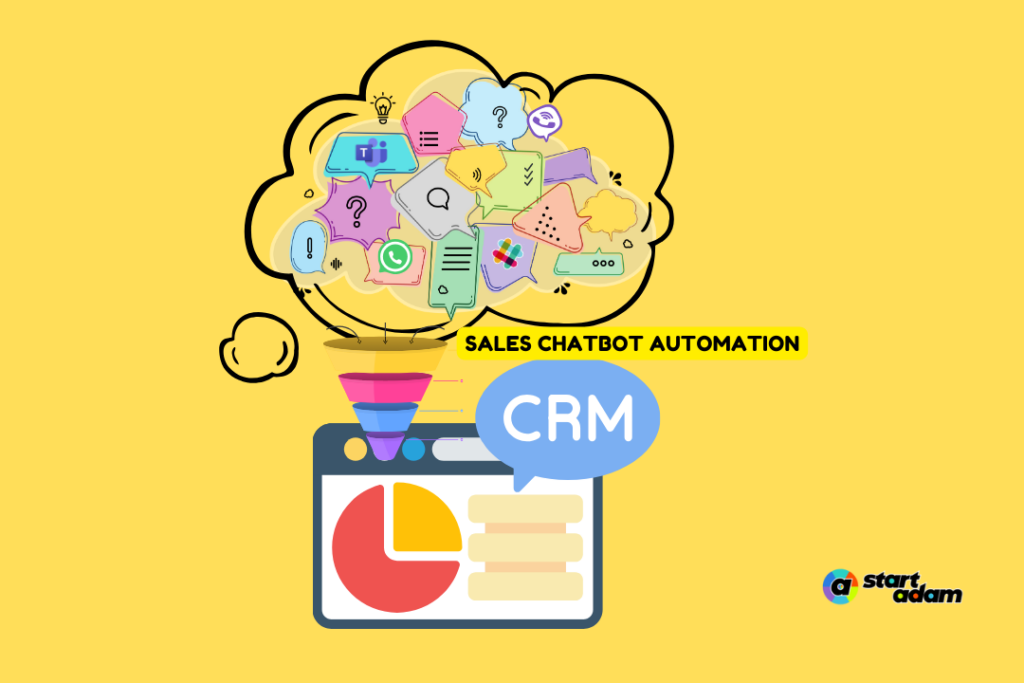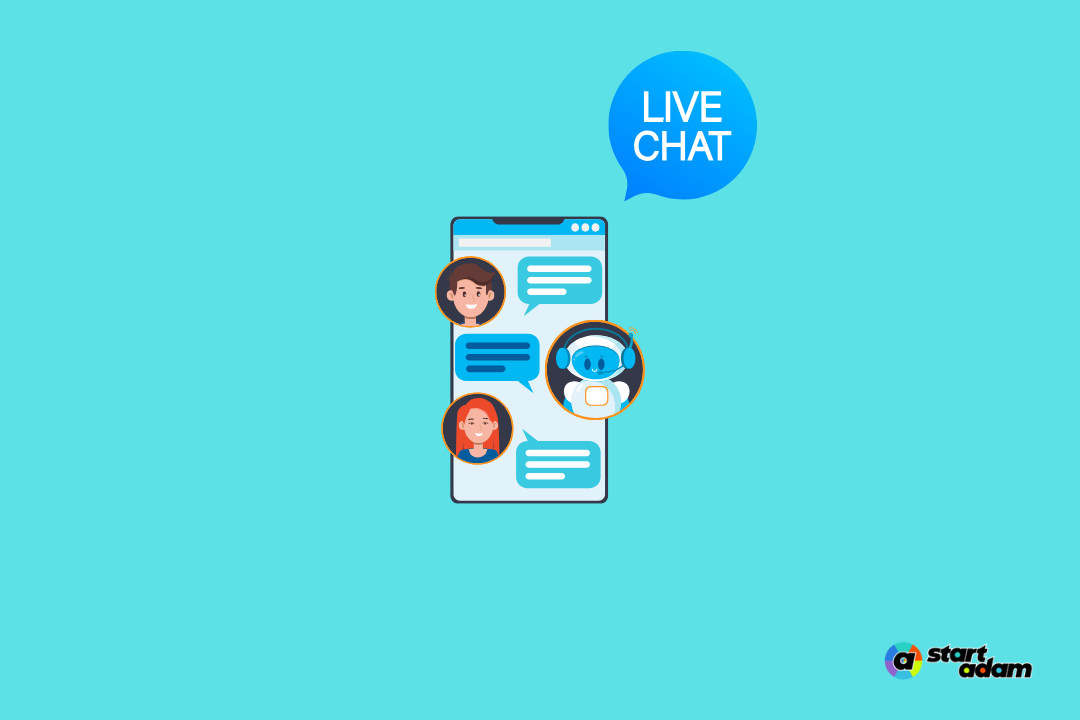A Complete Guide to Sales Chatbot Automation
March 18, 2024
July 22, 2024
5 min

Feeling like leads are slipping through your fingers?
Wondering where they’re going? Chatbots could be the answer you’re looking for.
Nowadays, technology has ways to bridge sales processes and solve problems. Let’s dive into how to close those gaps: engage with leads 24/7, and close more deals than ever. Say goodbye to phone tag and monotonous chores—”It’s working smarter, not harder!”
Let’s discuss how to simplify sales and drive revenue growth.
What Is Chatbot Automation?
Chatbot automation refers to utilizing AI-powered software to develop assistants capable of engaging in conversations with humans. Taken within the sales context, these AI chatbots for sales are designed to handle various aspects of the sales process, right from initial customer inquiries to follow-ups and support.
Chatbot for Sales Automation:
Sales bots are specifically programmed to:
- Qualify leads (Prompt follow-ups and draft responses)
- Answer product-related questions from a knowledgebase
- Schedule appointments
- Make personalized recommendations
- Process orders
- Provide post-sale support
By automating these tasks, businesses can significantly improve their efficiency and customer service capabilities.
3 Benefits of Sales Chatbot Automation
The use of AI sales bots in sales techniques is useful in a variety of ways:
1. Streamlined Customer Interactions
- Chatbots for sales provide responses to customer queries, reducing waiting periods and ensuring support 24*7.
- This promptness is essential for attracting and keeping the attention of clients.
2. Enhanced Customer Engagement and Satisfaction
- The use of personalized conversation and quick solution determination by AI chatbots in sales can efficiently improve customer satisfaction.
- They can remember customer preferences and past interactions, resulting in individualized experiences.
3. Increased Sales Efficiency
- Automation of routine tasks allows human sales representatives time to focus on more complex and high-value tasks.
- This enhancement has the potential to result in conversion rates and a boost in earnings.
How to Set Up a Sales Chatbot: A Step-by-Step Guide
The process of adding sales chatbots to your workflow doesn’t have to be overwhelming. Here’s a simplified guide:
Step 1: Clearly state your goals: Define what you want your chatbot to achieve.
Step 2: Choose the Right Platform: Select a system that meets your needs and integrates with your current setup.
Step 3: Design the Conversation Flow: Plan potential conversation paths.
Step 4: Create Content: Develop the dialogues and responses.
Step 5: Train Your Bot: Use AI to enhance understanding and responses.
Step 6: Test Thoroughly: Ensure your chatbot works smoothly in all scenarios.
Step 7: Launch and Monitor: Deploy your bot and continuously track its performance.
Key Features to Utilize
To maximize the effectiveness of your AI sales bot, focus on these key features:
- Natural Language Processing: This feature makes the bot understand and respond to language more naturally.
- Personalization: Tailor-made responses in the light of user data and behavior.
- Multichannel Integration: Allows the bot to work across various platforms (website, social media, messaging apps).
- Analytics and Reporting: Get valuable insight into the bot’s performance and customer interaction.
Designing Effective Chatbot Conversations
The success of your sales chatbot largely depends on effective conversation. Some tips for designing engaging dialogue include:
Creating Interesting Dialogues
- Keep it Conversational: Keep a warm and welcoming tone.
- Be Concise: Share details in bite-sized chunks.
- Offer Choices: Present users with choices to steer the discussion.
- Use Emojis Sparingly: They can add personality, but don’t overdo it.
Measuring Success: Key Metrics to Track
Understanding chatbot performance is vital for optimization. Here are the key metrics to monitor for assessing your chatbot’s efficiency and effectiveness.
| Metric | Description | Analytics Feature |
| Conversion Rates | Percentage of chatbot interactions leading to sales or desired actions | Real-time dashboards |
| Customer Satisfaction Scores | The measure of user happiness with chatbot experience | User sentiment analysis |
| Response Time | Speed of chatbot replies to inquiries | Conversation flow analysis |
| Retention Rate | Percentage of customers returning after chatbot interaction | A/B testing capabilities |
| Handoff Rate | Frequency of transfers from chatbot to human agents | Comprehensive analytics suite |
| Time Saved | Amount of human agent time conserved through chatbot use | Productivity tracking tools |
| Revenue Impact | Increase in sales attributable to chatbot interactions | Revenue attribution modeling |
Future Trends in Sales Chatbot Automation
The world of sales chatbots is evolving rapidly. Here are some trends one must look out for:
-
AI Next-Gen and Personalization:
Chatbots will learn and adapt to each customer’s preferences. This gives personalized interactions based on individual behavior patterns.
-
Emotional Intelligence and Predictive Analytics:
Chatbots will recognize emotions and predict customer needs. This will improve the quality of conversation and enable proactive problem-solving.
-
Human-AI Collaboration:
AI systems will handle routine tasks alongside human agents. This teamwork will boost sales efficiency and enhance customer satisfaction.

StartADAM revolutionizes sales team communication by unifying it on Live Chat. Some of its main features include:
- Round-robin chat management on Slack or Microsoft Teams
- AI auto-responses based on the history of conversation and knowledge base
- Intelligent lead capture, automatically collecting email addresses, following up, and integrating them into CRM
- Comprehensive chat record storage for future reference
- Seamless handoff to human team members when additional assistance is needed
StartADAM is a tool that facilitates communication within the sales team so as to ensure the efficient closure of deals.
Traditional Sales vs. Chatbot-Assisted Sales
To better understand the impact of chatbots, let’s compare traditional sales methods with chatbot-assisted sales:
| Aspect | Traditional Sales | Chatbot-Assisted Sales |
| Availability | Limited to business hours | 24/7 |
| Response Time | Can be delayed | Instant |
| Scalability | Limited by human resources | Highly scalable |
| Personalization | Depends on the individual salesperson | Consistent, data-driven |
| Cost | Higher (salaries, training) | Lower long-term costs |
| Handling Volume | Limited | Can handle multiple queries simultaneously |
StartADAM Your Sales Chatbot Solution
StartADAM stands out as the ultimate sales chatbot solution, offering unparalleled features, seamless integrations, and a proven record of success. But don’t just take our word for it—our case studies showcase how StartADAM has revolutionized the sales process for businesses like Sigvaris and Neutech.
With StartADAM, you’ll automate lead qualification by automating follow-ups and enhancing customer support with their innovative Unified Live Chat. This game-changing platform offers chat management, AI-powered auto-replies, and automated follow-ups that seamlessly integrate with your CRM.
Ready to take your business to the next level? Schedule a demo today and see exactly how StartADAM can work wonders for your sales operations, maximize efficiency, and drive exponential revenue growth. The sky’s the limit with StartADAM by your side!